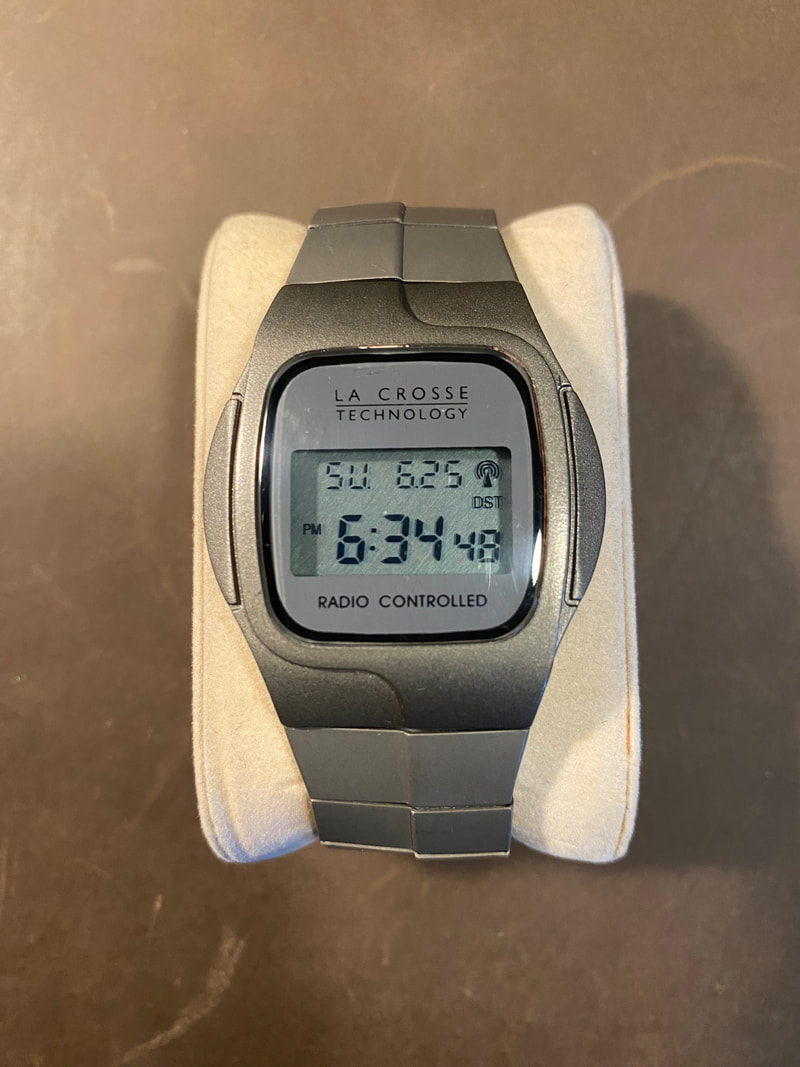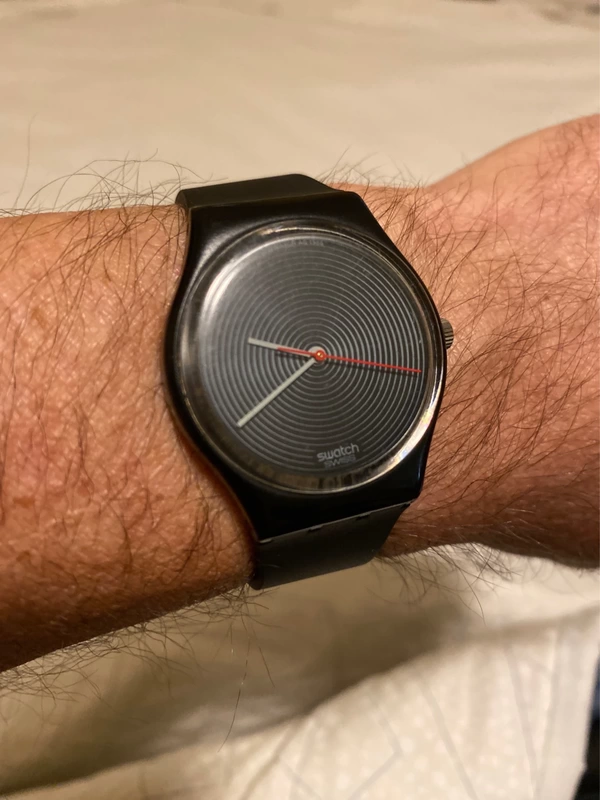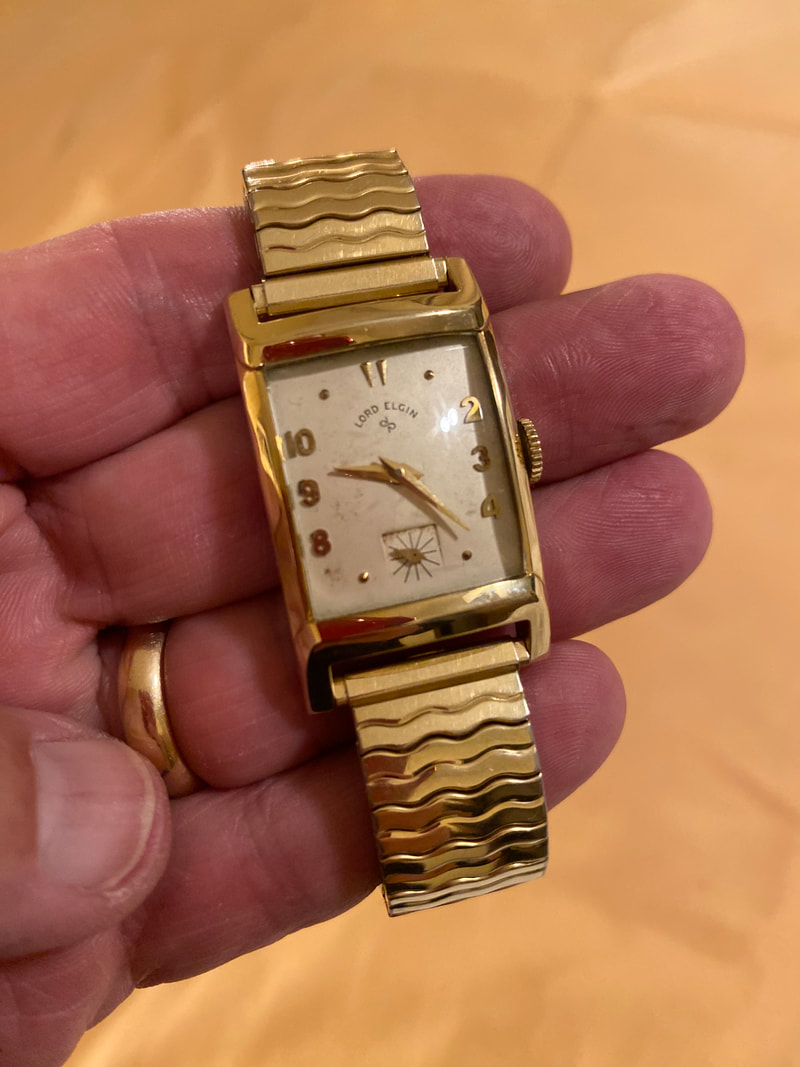Another of my “vintage” watches was a gift from my in-laws in the early oughts, otherwise known as “around the turn of the century.” (I’m beginning to notice that many watches I’ve had since new are now considered vintage. How is it that they become vintage and I am simply old?)
This is a La Crosse Technology WT-961(B) radio controlled watch. If you’re not familiar with La Crosse Technology, they make home weather stations and wall clocks that set their time from a signal broadcast by station WWVB from near Fort Collins, CO, by NIST (National Institute for Standards and Technology.) NIST it the nation’s time keeper and broadcasts a low frequency (LF) signal which transmits a binary code that defines the time. The LF bandwidth has a limited bandwidth so the code is sent at a bit rate of 1 Hz. It takes a full minute to transmit the date and time code. Clocks with WWVB receivers can decode the signal, synchronize their movement, and apply a time zone correction to the code, which is broadcast as Universal Coordinated Time (UTC).
So, as a watch, this one can do exactly two things. Receive the WWVB signal and apply a time zone adjustment. That’s it. It has no backlight. Its only button is recessed and requires something small, like the tip of a pen or toothpick, to press. This button can change the time zone, invoke the radio signal search manually, or turn off the watch. Functionally, that’s all a watch is really supposed to do, right? Well that’s everything and the only thing this one can do.
As a watch it is unquestionably the poorest quality instrument in my collection. It is eminently functional, and performs its basic tasks flawlessly; however, nothing else about it was designed to impress. The case and case back are plastic, the case back held in place by four fine Phillips head screws. The face does have a bit of texture molded in for visual interest. The links of the bracelet are plastic enclosed in thin metal sheets that wrap around each link. Links are removed by pushing out split pins and the stamped clasp has no micro adjustment. One side of each link is raised slightly from the other and this raised detail flows into the little bit of detail molded into the case face. In theory, it could be plainer, but not by much. When I received mine they came in black and grey. (I’m guessing the (B) in the model number for this one indicates the grey variant.)
The metal clad plastic bracelet seems unique to this watch and is surely its weakest point. If it should break no standard band would work. The watch case has a single central lug and the bracelet end links have two wide lugs that straddle the single case lug. If this watch was ever popular, I’m sure the bracelet was its major source of complaints.
Of course, none of this is surprising given that they were quite inexpensive. I can’t find a price reference for the time, but I seem to recall they were advertised in the back of the Parade magazine found in Sunday newspapers of the day. I’m sure those who remember those recall the fine quality products advertised there.
This one is in really great shape. I did wear it for a time, but as any other watch I had offered more features, I think I tired of this one quickly. But I put a new battery in it the other night and after 5-6 minutes of receiving the WWVB signal it set itself. I applied the time zone setting and it’s been holding perfect time since. I’m sure the movement is standard quartz level accurate but its ability to reacquire the signal and adjust nightly keeps things synchronized.
Of course, with the introduction of cellular communications, and smartwatches in particular, everyone carries a device tied to the time standard of that network. I’m intrigued that current G-Shock models with Bluetooth can connect to a mobile device via an app and pull the time from there. But back in 2001, WWVB was one of the few sources of such an accurate signal.
I don’t think I’ll ever wear it again and it hardly seems worthy of a pillow in my watch box. The bracelet is so inflexible it won’t fit in the drawer of the box either. Perhaps I’ll just remove the bracelet and keep the case in the drawer as a standard to check all my other watches by.
Addendum: YouTuber Greg Anderson, aka The Good Timekeeper, had done a nice little review you can watch here: https://www.youtube.com/watch?v=fSyhjBRoY5U.
This is a La Crosse Technology WT-961(B) radio controlled watch. If you’re not familiar with La Crosse Technology, they make home weather stations and wall clocks that set their time from a signal broadcast by station WWVB from near Fort Collins, CO, by NIST (National Institute for Standards and Technology.) NIST it the nation’s time keeper and broadcasts a low frequency (LF) signal which transmits a binary code that defines the time. The LF bandwidth has a limited bandwidth so the code is sent at a bit rate of 1 Hz. It takes a full minute to transmit the date and time code. Clocks with WWVB receivers can decode the signal, synchronize their movement, and apply a time zone correction to the code, which is broadcast as Universal Coordinated Time (UTC).
So, as a watch, this one can do exactly two things. Receive the WWVB signal and apply a time zone adjustment. That’s it. It has no backlight. Its only button is recessed and requires something small, like the tip of a pen or toothpick, to press. This button can change the time zone, invoke the radio signal search manually, or turn off the watch. Functionally, that’s all a watch is really supposed to do, right? Well that’s everything and the only thing this one can do.
As a watch it is unquestionably the poorest quality instrument in my collection. It is eminently functional, and performs its basic tasks flawlessly; however, nothing else about it was designed to impress. The case and case back are plastic, the case back held in place by four fine Phillips head screws. The face does have a bit of texture molded in for visual interest. The links of the bracelet are plastic enclosed in thin metal sheets that wrap around each link. Links are removed by pushing out split pins and the stamped clasp has no micro adjustment. One side of each link is raised slightly from the other and this raised detail flows into the little bit of detail molded into the case face. In theory, it could be plainer, but not by much. When I received mine they came in black and grey. (I’m guessing the (B) in the model number for this one indicates the grey variant.)
The metal clad plastic bracelet seems unique to this watch and is surely its weakest point. If it should break no standard band would work. The watch case has a single central lug and the bracelet end links have two wide lugs that straddle the single case lug. If this watch was ever popular, I’m sure the bracelet was its major source of complaints.
Of course, none of this is surprising given that they were quite inexpensive. I can’t find a price reference for the time, but I seem to recall they were advertised in the back of the Parade magazine found in Sunday newspapers of the day. I’m sure those who remember those recall the fine quality products advertised there.
This one is in really great shape. I did wear it for a time, but as any other watch I had offered more features, I think I tired of this one quickly. But I put a new battery in it the other night and after 5-6 minutes of receiving the WWVB signal it set itself. I applied the time zone setting and it’s been holding perfect time since. I’m sure the movement is standard quartz level accurate but its ability to reacquire the signal and adjust nightly keeps things synchronized.
Of course, with the introduction of cellular communications, and smartwatches in particular, everyone carries a device tied to the time standard of that network. I’m intrigued that current G-Shock models with Bluetooth can connect to a mobile device via an app and pull the time from there. But back in 2001, WWVB was one of the few sources of such an accurate signal.
I don’t think I’ll ever wear it again and it hardly seems worthy of a pillow in my watch box. The bracelet is so inflexible it won’t fit in the drawer of the box either. Perhaps I’ll just remove the bracelet and keep the case in the drawer as a standard to check all my other watches by.
Addendum: YouTuber Greg Anderson, aka The Good Timekeeper, had done a nice little review you can watch here: https://www.youtube.com/watch?v=fSyhjBRoY5U.



 RSS Feed
RSS Feed
